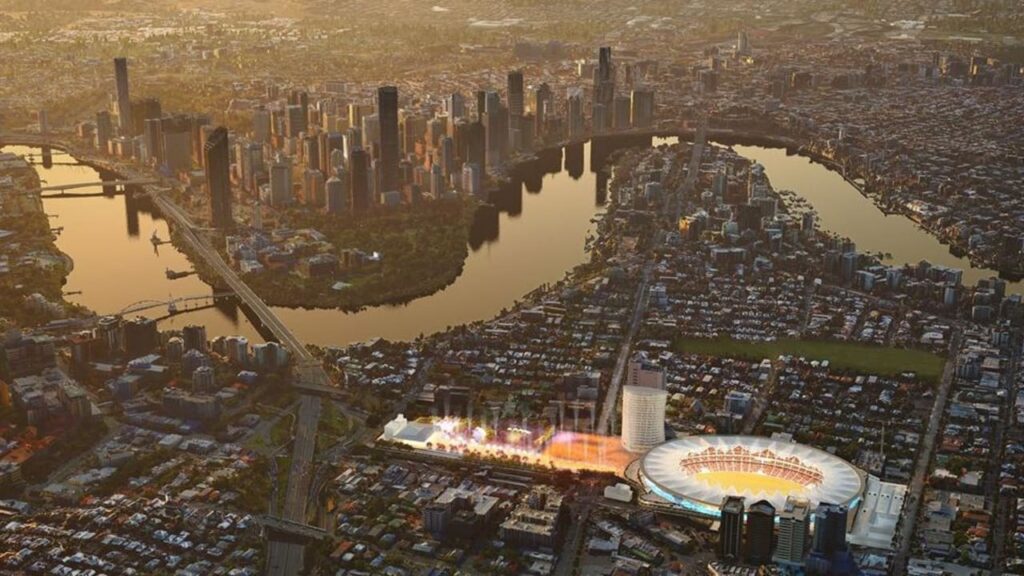Ever stopped to wonder who owns Queensland?
A crocodile hunter, a pub baron, a Japanese conglomerate and a handful of ultra-wealthy families are holding the keys to our great state.
Several Brisbane CBD infrastructure projects, worth a combined $12bn, will all come online in the next few years.

Who are the people behind Queensland’s biggest attractions? Source: Queensland Government
There’s Queen’s Wharf (at $3.6bn), of course; Cross River Rail, a $6.3bn underground metro-style system; and the $2.5bn Waterfront Brisbane precinct on the site of the old and since demolished Eagle Street Pier riverside complex.
So who is behind some of the state’s most iconic properties and projects?

Australia Zoo was founded by Bob and Lyn Irwin, parents of Crocodile Hunter Steve Irwin. Picture: NCA NewsWIRE/John Gass
AUSTRALIA ZOO
The most famous zoo in the country has only ever been owned by one household name: the Irwins.
Everyone knows Steve Irwin, the Crocodile Hunter, as the face of the zoo long after his passing; but when his parents, Bob and Lyn Irwin, founded the park, it had another face entirely.
First known as the Beerwah Reptile and Fauna Park – then the Queensland Reptile and Fauna Park – it was finally named “Australia Zoo” in 1998, after Bob and Lyn retired.

Steve Irwin’s wife Terri Irwin is now the owner of the zoo, who works with her kids Bindi and Robert Irwin on upkeep and conservation projects. Picture: Jamie McCarthy/Getty Images for Endometriosis Foundation of America
Husband and wife, Steve and Terri Irwin, took ownership of the park and Terri maintains ownership after the Crocodile Hunter’s death.
The Irwins have always had an interest in buying land for conservation purposes, also owning the Steve Irwin Wildlife Reserve in Cape York, Mourachan in St George, and Ironbark Station in Blackbutt.

The Gabba is one of Brisbane’s two big stadiums – and the Queensland Government struggled to figure out which area would host the Olympics.
THE GABBA AND SUNCORP STADIUM
Suncorp Stadium and the Gabba have been the home of Brisbane sport for more than 100 years: and it’s been the government’s responsibility to maintain them. Built in the late 1800s, the Gabba – then the Brisbane Cricket Ground – hosted cricket matches and greyhound racing until 1993, when the area was turned into a full-time stadium.
Suncorp Stadium was known as Lang Park when it was built over the former North Brisbane Cemetery in 1914, before being redeveloped over the new millennium to become the home of Queensland rugby league.

Suncorp Stadium will be hosting the opening ceremony of the 2032 games, while the Gabba will run team sports events at the same time. Picture: NCA NewsWIRE/John Gass
In 2001, parliament established Stadiums Queensland, which was put in charge of the Gabba and took over Suncorp Stadium when it was finished in 2003. The body is now the owner of 10 sporting hotspots, including the Queensland Sport and Athletics Centre, People First Stadium and North Queensland Stadium.
XXXX BREWERY
There are few beers more quintessentially Queensland than the XXXX brand – so it might be surprising to know that its brewery is no longer Australian-owned.
Brothers Nicholas and Edward Fitzgerald bought the Milton Brewery site where the iconic beer is made in 1877, as one of several “Castlemaine Brewery” establishments. In Brisbane, the brand found wild success, with the company becoming Castlemaine Perkins after buying Patrick Perkins’ brewing company in 1928.

Castlemaine Perkins was bought by Australasian beverage company Lion Nathan in 1992, now called Lion after being bought by Kirin Holdings Company in 2009, a Japanese conglomerate that controls alcohol and pharmaceutical businesses across the world, including in the US.

The Calile Hotel has been named one of the world’s best hotels for two years in a row.
THE CALILE HOTEL
The Calile Hotel is one of Brisbane’s newest landmarks, but it’s already been named one of the best hotels in the world.
The 1.8ha site where the hotel was built was bought in 2000 for $12.8m. The Malouf family, who immigrated from Lebanon in the 1890s, decided to turn the area into a world-class hotel.
Brothers Michael and Cal spent more than $100m on construction before opening in 2018. Named after their great grandfather and a common name in the family, the Calile was named in 2023 as the 12th best hotel across the globe by The World’s 50 Best. The Maloufs also run the James St Initiative, owning James St Market and retail shops across the entire road in Fortitude Valley where the hotel sits. The Maloufs are working on a similar hotel in Noosa.

Brothers Michael Malouf and Cal Malouf in the 2000s, before their work on the hotel and the massive James St Initiative. Picture: Tracey McBean, Sarah Marshall
BREAKFAST CREEK HOTEL
The Breakfast Creek Hotel has had a long and messy history, with its first owner falling to his death at the site.
Former Brisbane lord mayor William MacNaughton Galloway had the hotel built in 1889 to open the following year, quickly becoming a staple in the Albion suburb.
Five years later, Galloway, who had been drinking heavily for several weeks, fell off the second floor of the hotel and later died from his injuries.
Due to an outstanding mortgage, the hotel became owned by the Curator of Intestate Estates, eventually being sold off to brewing company Perkins & Co – the company XXXX Beer’s Castlemaine Brewery bought out in 1928.

The original owner of the Breakfast Creek Hotel actually died when he fell off the second floor. Picture: Liam Kidston
In the 1980s, the company sold the hotel to unit trust company Ausotel, which became owned by Carlton & United Breweries.
At the turn of the millennium, the hotel came into the hands of ALH Hotels, now a division of Endeavour Group, which invested $4.5m in its renovation. Endeavour is owned in part by grocery giant Woolworths and pub billionaire Bruce Mathieson.

The famous Bundy Bottle in front of the Bundaberg Rum Distillery and Museum: a locally run spot, despite its company being internationally owned.
BUNDABERG RUM DISTILLERY
Bundaberg’s famous rum distillery is so renowned you could almost forget it’s owned by the British. However, this wasn’t always the case.
The distillery was started up by seven Bundaberg locals to take advantage of the large quantities of molasses produced as waste from the town’s sugar mills.
Operations began in 1888, with the first batch of Bundaberg rum released the year after.
While the brewing company had gone into receivership in the 1890s, it remained Australian-owned for more than 100 years. It was only in 2000 that it was purchased by British company Diageo, renowned for brands Johnnie Walker, Smirnoff and Guinness.

The Story Bridge was built during the Great Depression, and has been taken care of by the Brisbane City Council ever since. Picture: Brisbane City Council
STORY BRIDGE
The Story bridge was designed and constructed in the 1930s, as one of three public works projects during the Great Depression. It had been planned for years, with the people of Brisbane needing to regularly get to Kangaroo Point across the Brisbane River. After finally opening in 1940, upkeep of the bridge remained with the government, with the Brisbane City Council repainting the bridge around every seven years.
A restoration of the bridge was recently completed by the council, which involved adding protective layers and thorough repairs to the structure’s concrete and steel.

The owners of the Wharf are Artemus Group: founders Adam Flaskas and Paul Henry, with CEO Luke Fraser.
HOWARD SMITH WHARVES
Howard Smith Wharves and the Story Bridge have their origins tied together – but unlike the Story Bridge, the renowned wharf went the way of private ownership.
Like the bridge, Howard Smith Wharves was constructed during the 1930s to combat the Great Depression. For several decades, the area was leased to the shipping company of the same name until its port moved from the site.
Fast-forward to the 2010s, and the Brisbane City Council was searching for interested parties to revive and redevelop the site. Come 2014, a candidate was found, which today is known as Artemus Group. Founded by Adam Flaskas and Paul Henry, and with Luke Fraser as CEO, hundreds of millions of dollars were spent on turning the wharf into a new dining hub for the city, opening to the public in 2018.
Now, Artemus is preparing for the Olympics, with a $620m project in the works to upgrade the location into a high-end tourist hotspot.

The local Porter family run Yatala Pie Shop, including general manager Susan Porter. Picture: Glenn Hampson
YATALA PIE SHOP
There’s been a pie shop in Yatala for more than a century: and while it hasn’t always had the same owners, it’s forever an Aussie establishment.
Having moved from the Pacific Highway to the Pacific Motorway in its long history, the shop has actually had 12 different owners.
Up until 1986, the last family who owned it were the Dreschers, still making their pies in a wood-fired oven. Then, the shop was purchased by the Porter family, Graham and Christine. The Porters have grown the business to the point it now sells around 3500 pies a day.

The airport is now run by a corporation with several shareholders, including QIC Infrastructure Management. Picture: Sarah Marshall/NCA NewsWire
BRISBANE AIRPORT
Brisbane Airport used to be one of the many services operated by the government – but after the privatisation of airports in the 1990s, it became an unlisted company owned by a series of shareholders.
Originally built over parts of the old Eagle Farm Airport. hundreds of millions of dollars went into its eight-year construction, finally opening in 1988. An international terminal was added in 1995.
But in 1997, the government ceased its ownership, with the Federal Airports Corporation selling the airport to the new Brisbane Airports Corporation.
Today, the majority share in BAC is owned by QIC Infrastructure Management, while Igneo Infrastructure Partners, IFM Investors, Royal Schiphol Group and Spirit Super also have significant stakes.
QUEEN’S WHARF BRISBANE
One of the biggest mixed-use precincts in the country, Queen’s Wharf opened this year – and it took the combined efforts of three big companies to make it.
In 2012, the state government announced plans to redevelop the 9ha of riverfront area, offering the project to willing corporations from the private sector. In 2015, Destination Brisbane Consortium was selected: a joint venture between three different companies, who could put $3.6bn into the project.
These corporations include Star Entertainment Group, Australia’s biggest listed casino group, and two partners from Hong Kong: Property Developer Far East Consortium and private conglomerate Chow Tai Fook Enterprises. Star owns the largest stake at 50 per cent.
On August 29, the wharf opened in the first of several phases, with The Star’s hotel and casino opening to the public along with seven restaurants and bars.
The post Here are the people who own Queensland’s biggest icons, locations and attractions appeared first on realestate.com.au.

